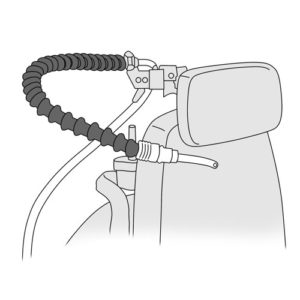Step 1: Anticipation

|
See the full description here
Summary:
Collaborate and form a team with your child. When you invest the time to form a strong team, children feel more comfortable and less anxious – this will help you complete the care with less stress – for you and your child.
Use these tips, from the start, to set the stage for a positive care procedure:
- Create the right moment: integrate the care in a routine.
- Alert your child to the needed care and communicate together.
- Form a team with your child: Encourage autonomy by offering realistic choices such as the method of distraction. Stay tuned to your child. Manage pain and anxiety, using distraction and positioning for comfort.
|
|
Step 2: Preparation
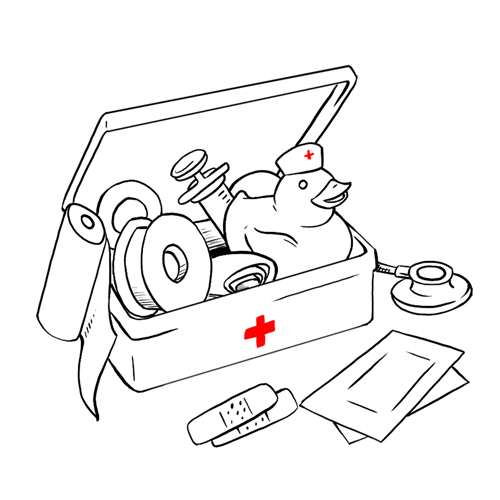
|
See the full description here
Summary:
- Prepare the environment: Identify a routine place for care. Close windows, doors and fans. Wash and dry the work surface and gather the needed materials for the care and to distract your child.
- Prepare your child: Get help if needed. Position your child for comfort to receive the care and start to use the selected distraction method.
- Prepare yourself: Find the right time when you are ready to provide the care safely. Review the list of care steps. Wash your hands.
Now that you are ready to start the care procedure, take the opportunity to encourage and praise your child.
|
|
Step 3: Procedure
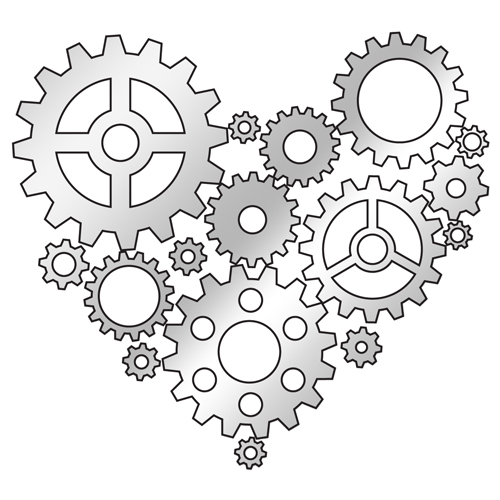
|
See the full description here
Summary 3 key concepts:
- Safety: Carefully follow the care practice steps as you have been taught.
- Flexibility: Be ready to adjust according to your child’s reactions during the procedure. As needed, reposition or select an alternative distraction strategy. Follow your child’s pace and rhythm.
- Collaboration: Reassure your child, verbally and non-verbally. Acknowledge your child’s emotions and reactions. Help your child differentiate between the different sensations during a procedure.
|
|
Step 4: Prepare the device

|
- Connect the device to an electrical wall outlet or an external battery. The built-in battery may also be used. Tip: If a battery is used, make sure that there is an adequate charge for the predicted duration of ventilatory assistance.
- Make sure that the antibacterial filter is connected to the air outlet of the respirator.

Why ? This step ensures the proper set-up for the ventilatory assistance device, in preparation for the next steps.
|
|
Step 5: Assemble the ventilation circuit
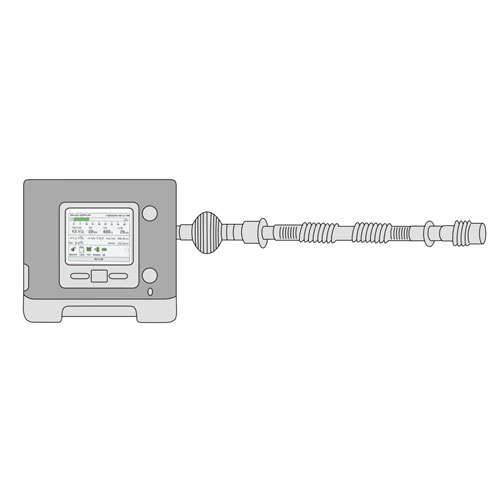
|
- Insert the tubing into the support arm.
- Connect the remaining parts of the circuit, making sure that the parts are securely joined.
- Attach the support arm to your child’s wheelchair.
- Position the support arm so that the end of the tubing is within easy reach of the child.
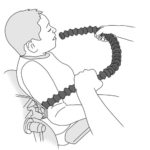
- Connect the circuit to the antibacterial filter.
- Verify that the tubing of the circuit is not bent, pinched or obstructed.
Why ? A correct assembly of the circuit parts avoids air leaks during ventilatory assistance.
Air leaks can reduce the effectiveness of ventilatory assistance.
|
|
Step 6: Prepare the mouthpiece
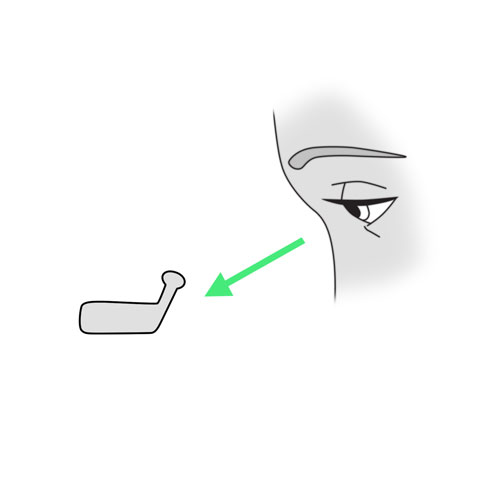
|
- Check that the mouthpiece is in good condition (not broken, cracked or dirty, etc.).
- Connect the mouthpiece to the tubing of the circuit, ensuring that it is securely joined.
Why ? Verifying that the mouthpiece is in good condition optimizes the ventilatory assistance.
A correct connection of the mouthpiece to the circuit avoids air leaks during ventilatory assistance.
|
|
Step 7: Position and prepare your child
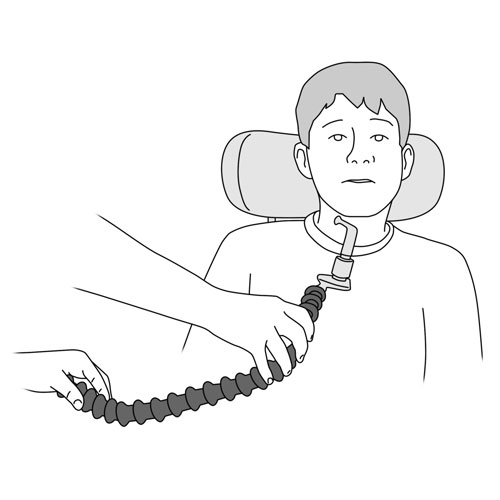
|
- Place your child in a comfortable position that easily allows the child to access the mouthpiece and to insert it into the mouth.
- Suction the secretions, if needed.
Why ? The best position is one where the child easily and independently accesses the mouthpiece.
|
|
Step 8: Turn on the device

|
- Press and release the start button of the device
- The backlight of the display should light up; red and yellow lights flash on briefly and a beeping sound is heard when the device is turned on.
Why ? This step allows your child to receive ventilatory assistance.
The device must be started BEFORE your child uses it to take an initial breath.
|
|
Step 9: Position the mouthpiece and start ventilatory assistance

|
- Make sure that the support arm is placed so that the child has easy access to the mouthpiece.
- Have your child press the lips firmly around the mouthpiece.
- Have your child breathe in to fill the lungs with air.
- After breathing in as much as possible, your child releases the mouthpiece and breathes out naturally.
Why ? This step connects your child to the ventilation circuit.
|
|
Step 10: Continue and supervise ventilatory assistance

|
While your child is receiving ventilatory assistance with the mouthpiece,
- Check that the device is working properly: when your child initiates a breath, there should be air flow and the pressure graph (green bar) on the device screen should be moving back and forth.
- Make sure that there are no significant air leaks around the mouthpiece or in the circuit; adjust or replace the parts as needed.
- Make sure that there is no tension or pulling on ventilation circuit, mouthpiece or support arm.
- Correct any device alarm situations, if any.
- Contact your child’s healthcare team for any persistent alarms.
Why ? This step ensures safe ventilatory assistance.
Air leaks may reduce the effectiveness of ventilatory assistance.
|
|
Step 11: Discontinue ventilation, remove the mouthpiece and turn off the device

|
When the period of ventilatory assistance for the child is over:
- Have your child release the mouthpiece from the mouth.
- Press and release the stop button on the device.
- Confirm your intention to turn off the device by pressing the button on the bottom right of the screen.
Why ? This step allows the ventilatory assistance to be discontinued safely and for the device to be turned off securely.
|
|
Step 12: Clean the mouthpiece
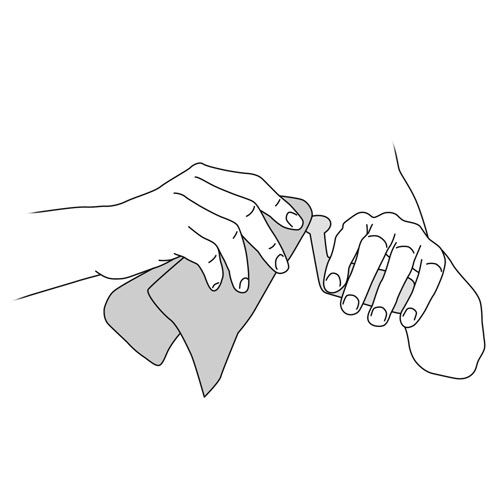
|
Clean the mouthpiece and store the equipment according to the recommendations.
Why ? This step is required to prevent infections and to maintain the equipment in working order.
|
|
Step 13: Recovery
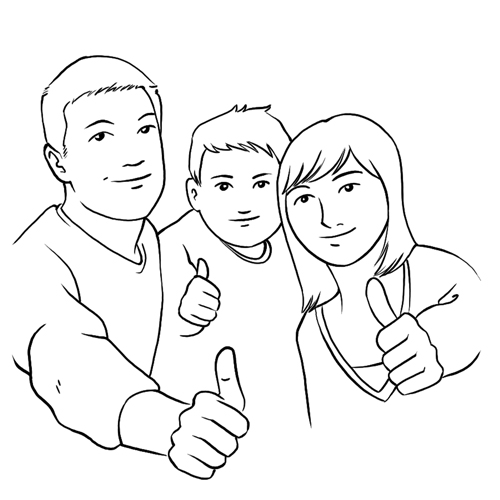
|
See the full description here
Summary:
The treatment is finished. Wash your hands again.
Be prepared to recognize the challenges faced and to provide positive feedback. Help your child recognize his/her strengths. Acknowledge the collaborative teamwork.
- Listen to what your child says about the parts of the procedure that were difficult or painful.
- Comfort your child and recognize your child’s collaboration with positive feedback.
- Highlight your child’s specific strengths that helped make the procedure positive.
- Discuss with your child what might be done the same or differently the next time the care is needed.
- Keep your promises if you have promised a reward, follow through.
- Reward yourself too.
|
|
![]()
